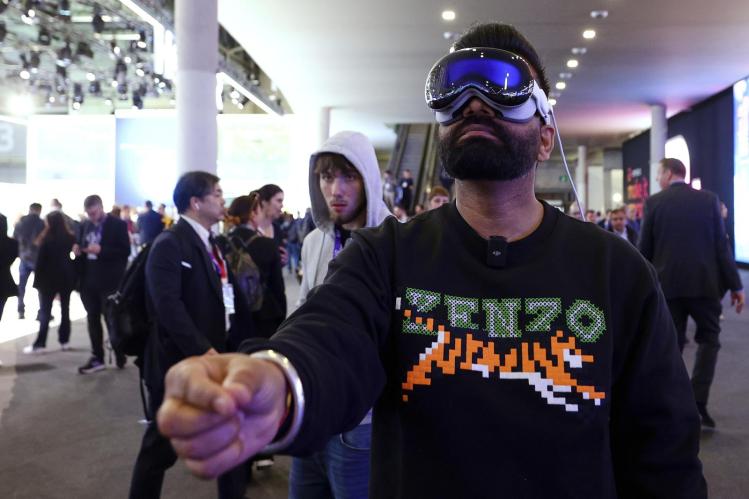
When I described using the new Apple Vision Pro virtual-reality headset to my mother, she said, “Maybe they come out with all these gadgets so that old people won’t feel so bad about having to die.” From friends I heard similar, if less morbid, reservations. “They should just stop with technology. It’s enough already.” “I want nothing to do with this.”
Of course, it’s not unusual for technological innovation to be met with criticism. Many scoffed at the iPhone when it first came on the market in 2007. Skeptical of the iPhone’s multiple functions, an Apple executive and future CEO of Palm asked, “Is there a toaster that also knows how to brew coffee?” New technology is also frequently met with so-called “moral panics.” In the 1920s, for example, the New York Times worried that listening to the radio too much could make children sick because the body could not “be kept up at the jazz rate forever.”
But much of the negativity about the Vision Pro is neither skepticism about its utility nor panic about its likely effects, but rather a wary resignation—like that of a lab rat tired of all the experiments but aware it won’t be able to resist another bite of cheese. We mostly take it for granted that digital technology comes with serious social and developmental drawbacks, even if these may not justify outright panic. As a result, most of us now look on our devices and the industry that makes them with a kind of dependent contempt. We’ve become reliant on some of their functions and addicted to others. We feel compelled to carry a trap around with us in our pockets.
The latest dubious convenience, suggested—but still only suggested—by the Vision Pro, would integrate the trap directly into our visual field, relieving us of the burden of taking out a device and looking at it.
In essence, the Vision Pro is noise-cancelling headphones for your eyes. It’s a pair of virtual-reality goggles that uses eight outward-facing cameras to capture and track external reality and re-present it to you. This “passthrough” technology, like transparency mode on AirPods, allows you to sense and navigate the world with something approximating normal aptitude. It also means that you can impose apps and windows from the Vision Pro’s operating system on the “real” world outside the device. You can, in other words, “augment” reality with the digital ghosts of your choice. A dial on the top of the device allows you to fine-tune the immersion: all the way up and you’re completely in a virtual environment; all the way down and you’re pretty much in the real world, just twelve milliseconds behind and with a pair of bulky metallic ski goggles strapped to your head. Meanwhile, the device’s eye- and hand-tracking sensors allow you to navigate its apps and settings without any keyboards or controllers. Essentially, your eyes are a mouse cursor and you click, scroll, and swipe through menus and apps with various hand gestures.
In full immersion, the device’s performance is compelling. Photos and videos feel uncomfortably real. At one point in the demo offered at Apple Stores, you’re placed inside a 3D home movie of a child’s birthday party that is so life-like it feels invasive. Slight constraints on peripheral vision still keep you at a remove, but your body is telling you that you should be able to move around these environments even if your brain knows you can’t. Though technologically impressive, these experiences are at the same time lonely and almost elegiac. You’re inserted into a kind of lost world or memory that you can’t share with anyone else. There’s also something creepy about them; they turn you into a paralyzed peeping Tom, lurking in a world you can’t affect. One shudders at the possibility of AI one day generating these worlds for us on command.
But this kind of immersive virtual reality had already established itself as a product category before the Vision Pro, albeit a rather niche one. What the Vision Pro has advanced, though not invented, is “mixed” or “augmented reality” (AR)—Apple calls it “spatial computing”—which allows users to integrate various digital functions directly into their experience of the real world. Apple is marketing the Vision Pro as a supercharged hybrid device mixing iPhone with computer with gaming console with movie theater. It can be used to get work done, Facetime with friends and family (as a video-game version of yourself), guide you as you cook, and distract you while you’re folding clothes—all without isolating you from the world and people around you—or so Apple tries to assure us. The Vision Pro even tries to create a sense of presence by projecting an image of your eyes onto the front of the device, which is as weird as it sounds.
To be fair, Apple is aware that this version of the technology is not ready for widespread consumer adoption. The $3,500 price tag seems as much a way of keeping it in the hands of developers and the tech-obsessed few as a reflection of its actual cost. Apple’s strategy is instead to offer a proof of concept—to show that this field is viable, that Apple should now be considered its leader, and that AR developers should focus their talents on developing useful applications for Apple’s visionOS operating system. It is positioning itself for a future when the tech becomes better, cheaper, less obtrusive, and perhaps also capable of what’s called “optical AR”—which would integrate virtual projections directly into our actual visual perception of the world instead of a camera-mediated version of it (something more like Alphabet’s failed Google Glass).
None of these advances, however, will change the basic facts about a device that is fundamentally isolating—occluding certain aspects of the real world in favor of a personalized “me-world” that can’t be shared with others. It’s fitting that you look like such an idiot while wearing it, since it effectively makes you into what the ancient Greeks called an “idiōtēs,” a private person incapable of participating in public life. “Spatialized computing” is another step in the effort, begun in earnest by the smartphone and earbuds (and echoed in the privatized politics of the neoliberal era), to make public life more private.
In his magnum opus Being and Nothingness, the existentialist philosopher Jean-Paul Sartre offers two examples to try to illuminate the basic character of intersubjectivity. In the first, he describes the experience of being alone in a park and suddenly seeing a man in the distance. The lawns and trees that just a moment ago were, in some sense, mine—an environment that seemed to present itself to me alone—are now shared. I’m aware of the man as a subject like me, someone who also has a perceptual claim upon “my” world. “Suddenly an object has appeared which has stolen the world from me,” Sartre writes. “It appears that the world has a kind of drain hole in the middle of its being and that it is perpetually flowing off through this hole.” Importantly, seeing this man as an object who is also a subject is irreducibly connected to the fact that I am both object and subject for him as well. For Sartre, my own subjectivity is inextricably tied to my sense that he senses it.
This comes through even more clearly in Sartre’s second example. Here, I’m peering through a keyhole and pressing my ear to a door to try to find out what’s going on inside when I suddenly hear footsteps in the hall behind me. Without even seeing the other person, I’m suddenly and shamefully aware that I and my subjectivity have become an object for another person.
Sartre uses these examples to make two main points. One is to dissolve a philosophical problem about the existence of other minds: How can I know for sure that other people are genuine subjects like me and not some kind of AI automaton? Sartre turns the question on its head. He shows that its premise—individual subjectivity—already presumes the existence of other minds. I get a sense of my own subjectivity through the (sometimes distressing) awareness of others’ subjectivity. In short, there is no subjectivity without intersubjectivity. Sartre’s second, less convincing point is that intersubjectivity always involves an antagonism between perspectives. “The essence of the relations between consciousnesses,” he writes, “is conflict.”
If Sartre is right about these ever-warring perspectives, the Vision Pro is a new weapon in the fight. My world no longer needs to “drain away” toward another’s person’s world. I can mold reality to my own specifications and live in a world that is mine alone, inaccessible to anyone else. Meanwhile, the elements of our shared world can become mere items on a menu, to be ordered on demand and forced to compete for my attention with virtual projections unburdened by physical constraints. No longer will we have to retreat to the cozy private worlds of our screens as a refuge against the public; we can now project our own worlds directly onto the world out there, while still remaining secure in the fact that no one else can see them. We can, in effect, become unashamed peeping Toms, able to curate our view as we like with no fear of being exposed ourselves.
It doesn’t take much imagination to foresee profoundly antisocial consequences. The videos of early adopters who’ve taken the Vision Pro out onto the street already offer some rudimentary indications: everyday interactions are overrun by virtual dinosaurs and YouTube videos, while fellow human beings are turned into images on the same level as a Twitter feed. To a troubling extent, the Vision Pro makes it possible to actualize a philosophically mistaken understanding of what it means to be a human being.
Early critiques have tended to focus on the device’s lack of utility. It’s not clear what need this device actually serves. But this is a little like criticizing heroin because it doesn’t increase productivity. The tech industry, ever since Apple helped reimagine its place in our lives with the iPod and the iPhone, doesn’t aim at utility exactly. It aims at addiction—creating products so well attuned to human instinct and perception that they become indispensable even if they seem, at least at first, as useless as a coffee-brewing toaster.
Of course, these devices seek to become indispensable not only so we buy them but also so that, once we’re captive to their “ecosystems,” value can be systematically scraped from us. For the tech industry, every instance of unmanipulated or untracked human attention represents lost value. Headsets like the Vision Pro promise to help capture that value. They present developers and advertisers with enticing new opportunities to track, steer, and monopolize our attention. If you think apps like TikTok and Instagram already addle and addict their users, distort personalities and relationships, and violate privacy norms, imagine them in ever-present immersive 3D tracking your every eye movement.
The Vision Pro may or may not be successful; it still has many hurdles to clear, both technologically and in terms of social acceptance. But it clearly signals that the tech industry will keep trying to strip-mine human consciousness for value no matter the consequences for individual well-being or the common good. This is technological innovation aimed not at satisfying our considered desires—or even our basest impulses—but at hijacking and exploiting our animal instincts.
A stock phrase has emerged among the tech cheerleaders touting the Vision Pro: “And just imagine,” they marvel, “this is the worst this technology will ever be.” If only. I’m afraid it will get much worse.
Please email comments to [email protected] and join the conversation on our Facebook page.
Previous Story
The Invisible Owners
Next Story
Distorting the Gospel


